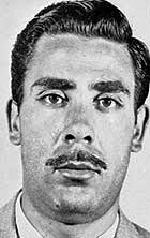According to Tommaso Buscetta the first Sicilian Mafia Commission for the province of Palermo was formed after a series of meetings between top American and Sicilian mafiosi that took place in Palermo between October 12-16, 1957, in the hotel Delle Palme and the Spanò sea-food restaurant.
US gangsters Joseph Bonanno and Lucky Luciano suggested that their Sicilian counterparts form a Commission following the example of the American Mafia which had formed their Commission in the 1930s.
 The Sicilians agreed with the suggestion and Buscetta, Gaetano Badalamenti and Salvatore Greco "Ciaschiteddu" set down the rules.
The Sicilians agreed with the suggestion and Buscetta, Gaetano Badalamenti and Salvatore Greco "Ciaschiteddu" set down the rules.
Sometime in early 1958 the Sicilian Mafia formed its first Mafia Commission. It was formed among Mafia families in the province of Palermo, which had the highest concentration of "cosche" (Mafia families), approximately 46. Salvatore "Ciaschiteddu" Greco was appointed as its first secretary or "rappresentante regionale", essentially as "primus inter pares" â the first among equals. Initially, the secretary had very little power. His task was simply to organize the meetings.
Before that time the Mafia families were not connected by a collective structure.
According to judge Cesare Terranova they "were a mosaic of small republics with geographical borders marked by tradition."
In the days before the Commission coordination inside Cosa Nostra was ensured by informal meetings among the most influential members of the most powerful families. In fact, the decision to form a Commission was a formalisation of these occasional meetings into a permanent, structured body.
Originally, to avoid an excessive concentration of power in the hands of a few individuals it was decided that only "men of honour" holding no leadership position within their own family â in other words simple "soldiers" â who could be appointed as members of the Commission.
That rule was immediately dropped due to the opposition of some Family-bosses who threatened to abandon the project from the start.
The Commission had two main functions. The first was to settle conflicts among Mafia families and single members, and to enforce the most serious violations of the normative codes of Cosa Nostra.
Second, the Commission was entrusted with the regulations towards the use of violence. It had exclusive authority to order the murder of police officials, prosecutors and judges, politicians, journalists and lawyers, as these killings could provoke retaliation by law enforcement. To limit internal conflicts, it was agreed that each Family boss had to ask the Commissionâs authorisation before killing any member of another Family.
Until the early 1980s the Commissionâs functions were often disregarded due to its colonial character and the wide autonomy for the Family bosses.
Only when Totò Riina, Bernardo Provenzano and the Corleonesi imposed their rules did the Commission become a central leadership body. However, the Commission in fact lost its autonomy and became a mere enforcement body that endorsed the decisions made by Riina and Provenzano.
The first Commission.
According to Buscetta the first Commission numbered "not many more than ten" and the number was variable.
Among the members of the first Commission in the province of Palermo were:
Salvatore Greco "Ciaschiteddu" for the Ciaculli mandamento (Palermo)
Antonio Matranga for the Resuttana mandamento (Palermo)
Mariano Troia for the San Lorenzo mandamento (Palermo)
Michele Cavataio for the Acquasanta mandamento (Palermo)
Calcedonio Di Pisa for the Noce mandamento (Palermo)
Salvatore La Barbera for the Palermo Centro mandamento
Cesare Manzella for the Cinisi mandamento
Giuseppe Panno for the Casteldaccia mandamento
Antonio Salamone for the San Giuseppe Jato mandamento
Lorenzo Motisi for the Pagliarelli mandamento (Palermo)
Salvatore Manno for the Boccadifalco mandamento (Palermo)
Francesco Sorci for the Santa Maria di Gesù mandamento (Palermo)
Mario Di Girolamo for the Corso Calatafimi mandamento (Palermo)
The Commission, however, was not able to prevent the outbreak of a violent Mafia War in 1963.
"Casus belli" was a heroin deal gone wrong, and the subsequent killing of Calcedonio Di Pisa on December 26, 1962, who was held responsible. Instead of settling the dispute, the Commission became part of the internal conflict.
On June 30, 1963, a car bomb exploded near Grecoâs house in Ciaculli, killing seven police and military officers sent to defuse it after an anonymous phone call. The outrage over the Ciaculli massacre changed the Mafia war into a war against the Mafia. It prompted the first concerted anti-mafia efforts by the state in post-war Italy.
The Sicilian Mafia Commission was dissolved and of those mafiosi who had escaped arrest many went abroad. "Ciaschiteddu" Greco fled to Caracas in Venezuela.
According to Tommaso Buscetta it was Michele Cavataio, the boss of the Acquasanta quarter of Palermo, who was responsible for the Ciaculli bomb, and possibly the murder of boss Calcedonio Di Pisa in late 1962.
Cavataio had lost out to the Grecoâs in a war of the wholesale market in the mid 1950s. Cavataio killed Di Pisa in the knowledge that the La Barberaâs would be blamed by the Grecoâs and a war would be the result. He kept fuelling the war through other bomb attacks and killings.
Cavataio was backed by other Mafia families who resented the growing power of the Mafia Commission at the expense of individual Mafia families. Cavataio was killed on December 10, 1969, in the Viale Lazio in Palermo in retaliation for the events in 1963, by a Mafia hit-squad - including Calogero Bagarella, Bernardo Provenzano, and Giuseppe Di Cristina.
Video about our Godtfather excursion